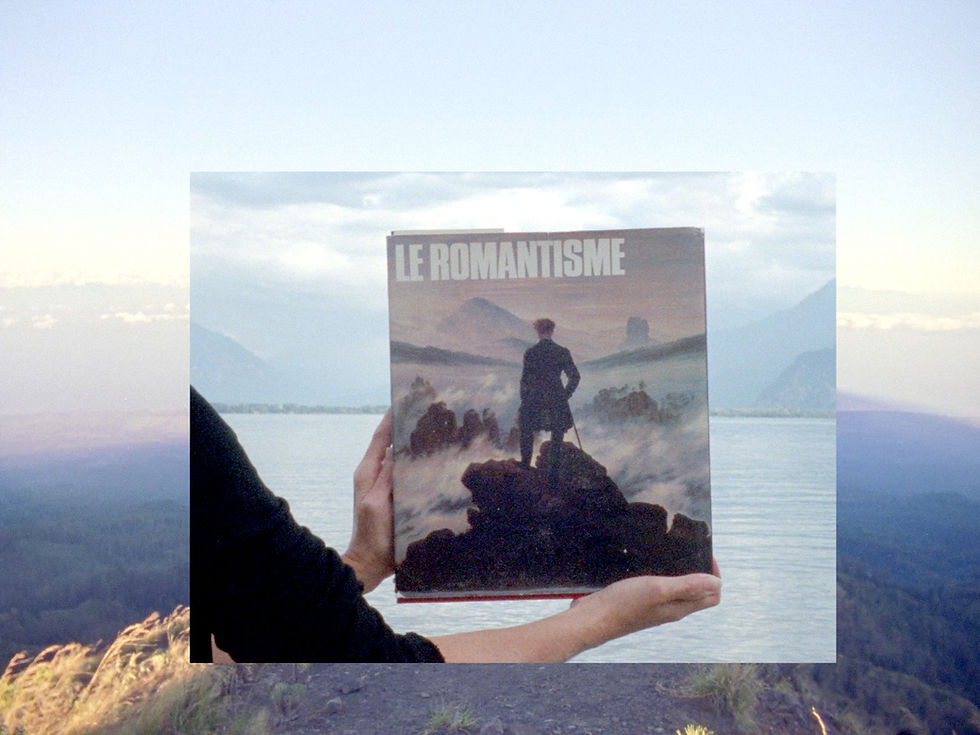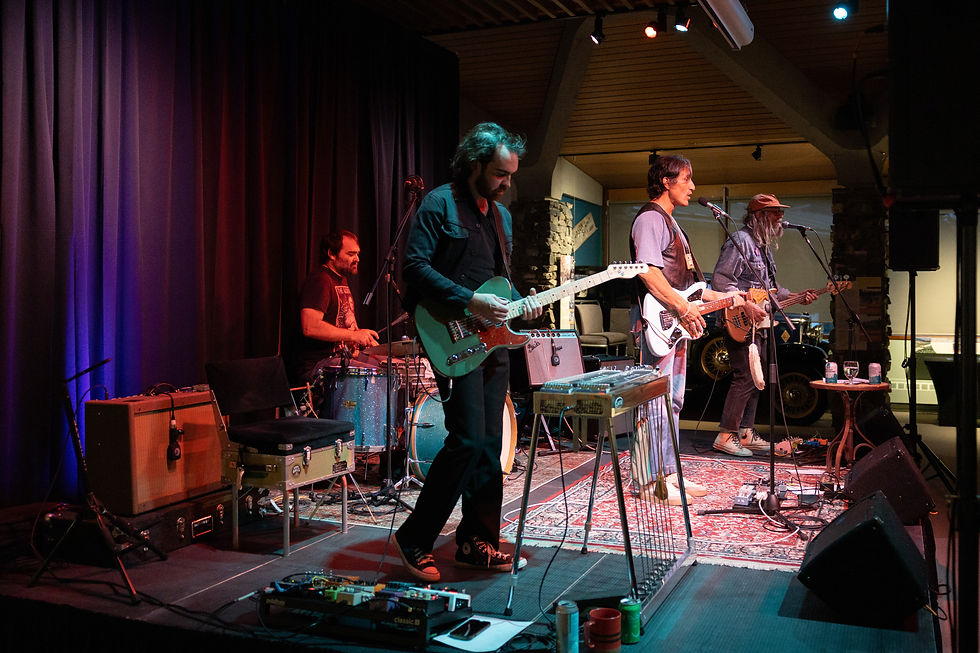Q&A With Artist Elise Rasmussen On "An Alpine Trilogy"
- whytemuseum
- Sep 9, 2025
- 6 min read
Updated: Sep 17, 2025
By Tera Swanson, Marketing and Communications Manager

Across generations, mountain landscapes have been influential foundations of identity and meaning, rooting a spectrum of experiences and cultures within a shared sense of place. Yet many of these perspectives are intertwined in complex histories, creating layered narratives behind how these landscapes are celebrated, romanticized, contested, and claimed.
What are the roots of these perspectives, and how might we re-evaluate them differently today through a more nuanced lens?
Opening November 1, 2025, at The Whyte, Elise Rasmussen: An Alpine Trilogy takes this question into the heart of the Alps. Through three interlinked bodies of work that resonate deeply in Banff, Rasmussen reframes histories of conquest, grandeur, and nostalgia.
Rasmussen asks us to look past the postcard alpine sublime and notice the instruments, both scientific and cultural, that made those views possible.
— Christina Cuthbertson, Chief Operating Officer and Curator
The trilogy incorporates several different media, culminating throughout The Whyte's gallery walls and spaces as a multi-room presentation of photographs, cyanotypes, and film installations, featuring collective works from three projects.
Born in Edmonton, Canada (Treaty 6, Amiskwacîwâskahikan), Elise Rasmussen lives in Los Angeles, California (Tovaangar, homelands of the Gabrielino-Tongva peoples) and is currently an artist-in-residence at Triangle in Brooklyn, NY.
We connected with Elise to get her first-hand perspective on her works in her own words, and to learn what she's hoping audiences at The Whyte will take away after visiting.

For readers new to your work, how would you introduce this project in a sentence or two? What ties the three works in An Alpine Trilogy together?
An Alpine Trilogy is comprised of photographs, cyanotypes and film installations from three projects created between 2017-2025: Did You Know Blue Had No Name?, The Year Without a Summer, and Nostalgia: A Return to the Alps in Five Vignettes. These works juxtapose historical narratives related to the Alps with contemporary concerns regarding land stewardship, post-colonialism and the climate crisis. This will be the first time showing works from all three of my Alps-related projects together.
What sparked the initial idea, and what core question are you exploring through your work?
The genesis for creating these projects came from time spent on an artist residency at the Banff Centre as a Barbara Spohr Memorial Award recipient in 2017. While on the residency, I was looking at the origins of Banff as a National Park, and I learned about the role that Swiss Mountain Guides played in the creation of mountain culture and tourism in the Canadian Rockies. I began to trace this history back to the origins of mountaineering in Europe, and this led me to the story of the first ascent of Mont Blanc. I became particularly fascinated by Horace Bénédict de Saussure’s cyanometer (a colour wheel used to measure the blueness of the sky) and how Saussure’s desire to test this and other scientific instruments became a driving force in his quest to conquer Europe’s tallest mountain. This research led me to the creation of my first work on the Alps: Did You Know Blue Had No Name? which weaves together various epistemologies related to “blueness,” examining the colour blue and its influence on mountaineering, early photographic technologies, art history, and how knowledge is ascribed and recorded.

How did research or lived experience shape what we encounter in the final work?
My research-based practice weaves together disparate histories mediated through my subjective experience. In all of my projects, I spend time in archives and in the geographical location which I am researching (in this case, the Alps), and this permeates into what is shared through my photographs and films. In Nostalgia: A Return to the Alps in Five Vignettes, I revisit sites in Switzerland that were vital to the creation of literary works by Rilke, Fitzgerald, and Mann, looking at how these places occupy a space that is simultaneously physical as well as imaginary. In The Year Without a Summer, I investigate the eruption of Mount Tambora in Indonesia, which resulted in an environmental anomaly on the world’s weather patterns between 1815 and 1816. This had a great influence on art coming out of this period (such as in the works of Turner and Friedrich) and influenced Mary Shelley’s writing of Frankenstein. For this project I hiked to the top of Mount Tambora in Indonesia to film the site of the eruption, filmed Turner’s sketch books housed at the Tate in London, and I spent three months on an artist residency on Lake Geneva (which was the same amount of time Mary Shelley spent on the lake in the Summer of 1816). My experiences in all of these places are woven into the narrative of the film.

Was there a challenge or surprise that changed the direction of the project? A research rabbit hole or on-the-ground moment?
While I was on my residency at La Becque working on The Year Without a Summer, I fractured my hip and was on crutches for the last six weeks of my stay. This meant forfeiting shoots I had planned, and it threw a wrench into my plans for the project. I began to consider the similarities of my experience in the summer of 2019 to that of Mary Shelley’s experience in the summer of 1816. Due to terrible weather, she and her literary friends were forced indoors instead of boating and hiking around Lake Geneva, and to pass the time, they created a ghost story competition, which resulted in her writing Frankenstein. Because my mobility was limited, I decided to turn my camera inward and use the site of the residency itself. My fellow artists-in-residence became my stand-in for Mary Shelley and her circle. Had I not fractured my hip, the work would be a completely different piece. I was also lucky that La Becque is remarkably beautiful and a great place to convalesce, and it was through this convalescence that I started considering the relationship between the Alps and health, and how this concept has been propagated through literature and tourism. I began investigating sanatorium culture and how the Alps have cultivated the promise of being a place where one’s physical and mental health is restored. This became the premise for Nostalgia: A Return to the Alps in Five Vignettes, and three years later I returned to Switzerland to attend the Villa Ruffieux residency where I began shooting this piece.
What do you hope visitors notice first, and what reward is there for a slower look?
I attempt to make my work accessible for viewers in that they do not have to come to the show knowing all of these disparate histories to which I am referencing. The works can unfold on many different levels. The photographs and cyanotype installation have a visual quality which will invite viewers into the gallery, and the more time spent with the films will lead to a deeper understanding of the works and how the stories represented have universal themes.
Who did you collaborate with in producing this work, and how did that shape the outcome?
I am greatly influenced by attending artist residencies and all of these projects were created with support from residencies which have provided time, space and community, which have ultimately shaped my work.
What parallels can you draw from this particular piece of work within the context of Banff National Park? What drew you to present your work at The Whyte?
I am really excited to show this work at The Whyte as it feels like it is coming full circle in returning to the place where it was first conceptualized. Although the works relate directly to the Swiss/French Alps, there are nods to my roots of having grown up in Alberta and having spent a lot of my childhood in the Rocky Mountains. I do think there are a number of parallels that can be drawn between the Alps and Banff, not only with regard to mountain-scapes and mountaineering, but also in considering how tourism has shaped these places and how climate change is a visible threat to these environs. The Whyte has an incredible collection of archives, which I have only recently discovered, and this is a wonderful resource that fits nicely with my working methodology (and may lead to future work).
Aside from the upcoming exhibition at The Whyte, what’s next for you and where can people follow or engage with your work?
Right now, I am in a group show, “Femicide,” at the Shiva Gallery at the John Jay College of Criminal Justice, CUNY, which runs from September 3 to October 24.
People can always have a look at my website or follow me on Instagram @eliseseye to see more of my work and keep up with what I have going on.
Elise Rasmussen: An Alpine Trilogy is on at The Whyte from November 1, 2025, to April 12, 2026, curated by Christina Cuthbertson. To learn more about this exhibition and plan your visit, visit whyte.org/exhibitions or stop by in person at 111 Bear Street, Banff, Alberta.
Images:
Image 1: Still from “Did you know blue had no name?”, 16mm film transferred to HD Video w Stereo Sound, 6:36 (looping), 2018
Image 2: Still from “The Year Without a Summer,” 16mm film transferred to 4K Video w Quadrophonic Sound, 20:05, 2020
Image 3: “Frankenstein,” 40x50in C-Print, 2020
Image 4: Still from “The Year Without a Summer,” 16mm film transferred to 4K Video w Quadrophonic Sound, 20:05, 2020



Comments